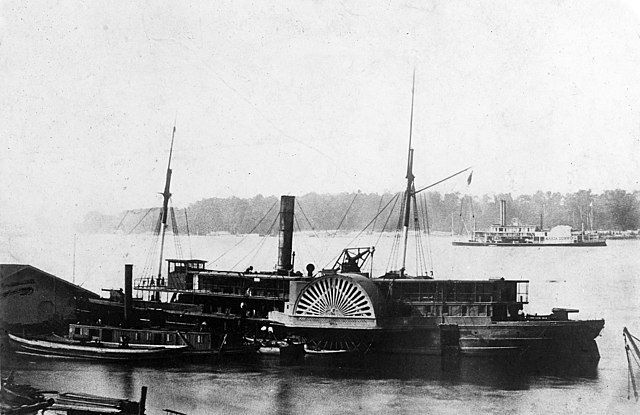Cottonclads were a classification of steam-powered warships where a wooden ship was protected from enemy fire by bales of cotton lining its sides. Cottonclads were prevalent during the American Civil War, particularly in the Confederate States Navy for riverine and coastal service such as in the battles of Memphis, Galveston, and Sabine Pass. Confederate tactics generally had cottonclads, which were outgunned by Union warships, steam at full speed towards enemy vessels, relying on the cotton to absorb fire. Once they were within firing range, they would open fire, and, if possible, ram or board the enemy.
CSS Stonewall Jackson
(Ex CSS) USS General Bragg, probably photographed at Cairo or Mound City, Illinois, circa 1862–63.
The First Battle of Memphis was a naval battle fought on the Mississippi River immediately north of the city of Memphis, Tennessee on June 6, 1862, during the American Civil War. The engagement was witnessed by many of the citizens of Memphis. It resulted in a crushing defeat for the Confederate forces, and marked the virtual eradication of a Confederate naval presence on the river. Despite the lopsided outcome, the Union Army failed to grasp its strategic significance. Its primary historical importance is that it was the last time civilians with no prior military experience were permitted to command ships in combat. As such, it is a milestone in the development of professionalism in the United States Navy.
USS (ex-CSS) Little Rebel
(Ex CSS) USS General Bragg probably photographed at Cairo or Mound City, Illinois, circa 1862–63.
The Total Annihilation of the Rebel Fleet by the Federal Fleet under Commodore Davis. On the Morning of June 6, 1862, off Memphis, Tenn. CSS General Beauregard (center foreground) is being rammed by the federal ram Monarch. At left are the disabled federal ram Queen of the West and the Confederate ships General Sterling Price and Little Rebel.




